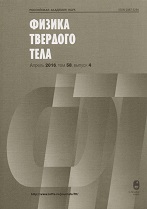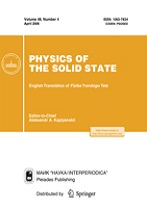|
Phase transitions
Excitonic metal–insulator phase transition of the Mott type in compressed calcium
T. O. Voronkova, A. M. Sarry, M. F. Sarry, S. G. Skidan
Federal State Unitary Enterprise "Russian Federal Nuclear Center — All-Russian Research Institute of Experimental Physics", Sarov, Nizhny Novgorod region
Abstract:
It has been experimentally found that, under the static compression of a calcium crystal at room temperature, it undergoes a series of structural phase transitions: face-centered cubic lattice → body-centered cubic lattice → simple cubic lattice. It has been decided to investigate precisely the simple cubic lattice (because it is an alternative lattice) with the aim of elucidating the possibility of the existence of other (nonstructural) phase transitions in it by using for this purpose the Hubbard model for electrons with half-filled ns-bands and preliminarily transforming the initial electronic system into an electron–hole system by means of the known Shiba operators (applicable only to alternative lattices). This transformation leads to the fact that, in the new system of fermions, instead of the former repulsion, there is an attraction between electrons and holes. Elementary excitations of this new system are bound boson pairs–excitons. This system of fermions has been quantitatively analyzed by jointly using the equation-of-motion method and the direct algebraic method. The numerical integration of the analytically exact transcendental equations derived from the first principles for alternative (one-, two-, and three-dimensional) lattices has demonstrated that, in systems of two-species (electrons + hole) fermions, temperature-induced metal–insulator phase transitions of the Mott type are actually possible. Moreover, all these crystals are in fact excitonic insulators. This conclusion is in complete agreement with the analytically exact calculations of the ground state of a one-dimensional crystal (with half-filled bands), which were performed by Lieb and Wu with the aim to find out the Mott insulator–metal transition of another type.
Received: 25.05.2016
Revised: 09.10.2016
Citation:
T. O. Voronkova, A. M. Sarry, M. F. Sarry, S. G. Skidan, “Excitonic metal–insulator phase transition of the Mott type in compressed calcium”, Fizika Tverdogo Tela, 59:5 (2017), 951–958; Phys. Solid State, 59:5 (2017), 977–985
Linking options:
https://www.mathnet.ru/eng/ftt9587 https://www.mathnet.ru/eng/ftt/v59/i5/p951
|


| Statistics & downloads: |
| Abstract page: | 51 | | Full-text PDF : | 15 |
|





 Contact us:
Contact us: Terms of Use
Terms of Use
 Registration to the website
Registration to the website Logotypes
Logotypes









 Citation in format
Citation in format 